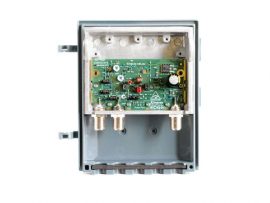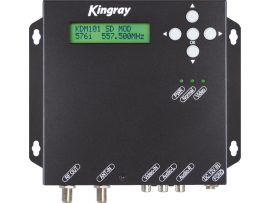Description
Kingray KOR100X Optical Fibre Receiver
The Kingray KOR100X Optical Fibre Receiver uses a high-sensitivity PIN detector. The digital TV frequency range is 47~2600MHz on a single fibre and is compatible with any FTTx PON system to achieve a triple-network combination between Digital TV (DVB-C, DVB-T), Satellite TV (DVB-S) and Internet (Data).
The Kingray KOR100X Optical Fibre Receiver has a built-in WDM to separate wavelengths of 1550nm (CATV) and GPON & XGS-PON (data).
AGC function on the RF output provides a typical RF level of 85dB.
The optical receiver is powered by a Kingray PSK12S power supply (sold separately). Foxtel Approved.
Foxtel Approved.
This model replaces the Kingray KOR100.
Key Features
- Frequency Range 47~2600 MHz
- Built-in WDM to separate wavelengths of 1550~1560nm (CATV) and GPON & XGS-PON (data)
- Receiving Sensitivity Range: -13dBm to +1dBm
- RF Output Level with AGC: Typically 81~85dB
- Suitable for Digital TV and SATELLITE RF signals
- Digital TV (DVB-C, DVB-T) and Satellite TV (DVB-S) signal can be received via a single fibre at the same time
- LED Indicator
- Compact in design, wall mountable and light weight
- Optical Connector: SC/APC
- RF Connector: F-Female
RF over fiber (RFoF) is a technology that enables the transmission of radio frequency (RF) signals over optical fiber cables. It combines the advantages of both radio frequency and fiber optic communication systems, providing long-distance transmission, low signal loss, high bandwidth, and immunity to electromagnetic interference. RFoF is commonly used in various applications, including telecommunications, satellite communications, wireless networks, and military systems.
Here’s a basic explanation of how RF over fiber works:
- Modulation: The RF signal, typically in the range of a few megahertz (MHz) to several gigahertz (GHz), is modulated onto an optical carrier signal. Modulation can be done using techniques like intensity modulation, where the intensity of the optical signal is varied according to the amplitude of the RF signal.
- Optical Transmission: The modulated optical signal is then transmitted over a single-mode or multimode optical fiber. Optical fibers are used because they offer low signal attenuation and can transmit data over long distances with minimal losses.
- Fiber Link: The optical fiber serves as a transmission medium, and it carries the modulated RF signal from one end to the other. The RFoF link can span several kilometers or even longer, depending on the quality of the optical fiber used.
- Optical-to-Electrical Conversion: At the receiving end of the fiber link, the optical signal is converted back into an electrical signal. This process involves using an optical receiver that converts the light signals into electrical currents.
- Demodulation: The electrical signal is then demodulated to retrieve the original RF signal. The demodulation process essentially reverses the modulation performed at the transmitting end.
- Signal Amplification: In some cases, signal amplifiers might be used at certain intervals along the fiber link to compensate for signal losses and maintain signal integrity.
Benefits of RF over Fiber:
- Signal Quality: RFoF preserves the signal quality over long distances, as optical fiber has very low signal attenuation compared to traditional coaxial cables.
- EMI Immunity: Since the RF signals are transmitted optically, RFoF is immune to electromagnetic interference (EMI) and radio frequency interference (RFI).
- Bandwidth: Optical fibers offer high bandwidth capabilities, allowing for the transmission of a wide range of RF frequencies simultaneously.
- Lightweight and Compact: RFoF systems can replace bulky and heavy coaxial cables, making installations more manageable and efficient.
- Secure Communication: Optical fibers provide a high level of security as they are difficult to tap into or intercept compared to traditional copper cables.
RF over fiber is a versatile technology that can be used in various applications where long-distance, high-quality RF signal transmission is required. Its ability to integrate with existing fiber optic infrastructure and radio frequency systems makes it an attractive solution for modern communication networks.
About Kingray
Kingray is a proud Australian-owned company established in 1959 by founder Ted Dunn.
Since the distant days of the monochrome VHF service, in fact for almost as long as television has been available in Australia, Kingray have been one of the major players in the TV service industry.
In the 1960s and 70s Standard Communications revolutionised the Australian MATV market with the Kingray range of broadband high power distribution amplifiers.
The success of the Kingray product range evolves from carefully listening to customers, being intimately involved in markets, having the foresight and vision to take a perceived problem, converting it to an opportunity and generating a practical solution.
With the changes in Digital Television technologies, Kingray’s research and development efforts have accelerated to ensure the compatibility of Kingray products and to enhance the range with additional products that meet and surpass customers’ expectations for quality, performance and price.
Sixty years later, Kingray continues to grow today & into the future, with a diversified product range to accommodate a new era of delivering Satellite & TV services over optical fibre cable.
Kingray’s sustaining objective is to provide customers with not just the most appropriate product for the job, but to ensure the ongoing delivery of professional customer service that has become the hallmark of Kingray.







